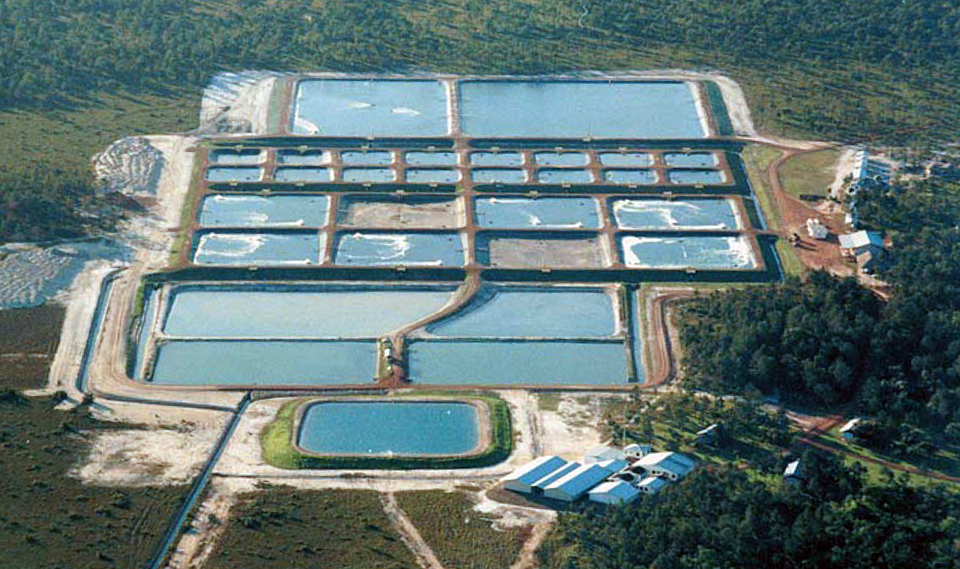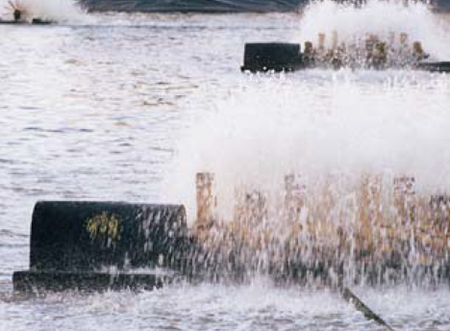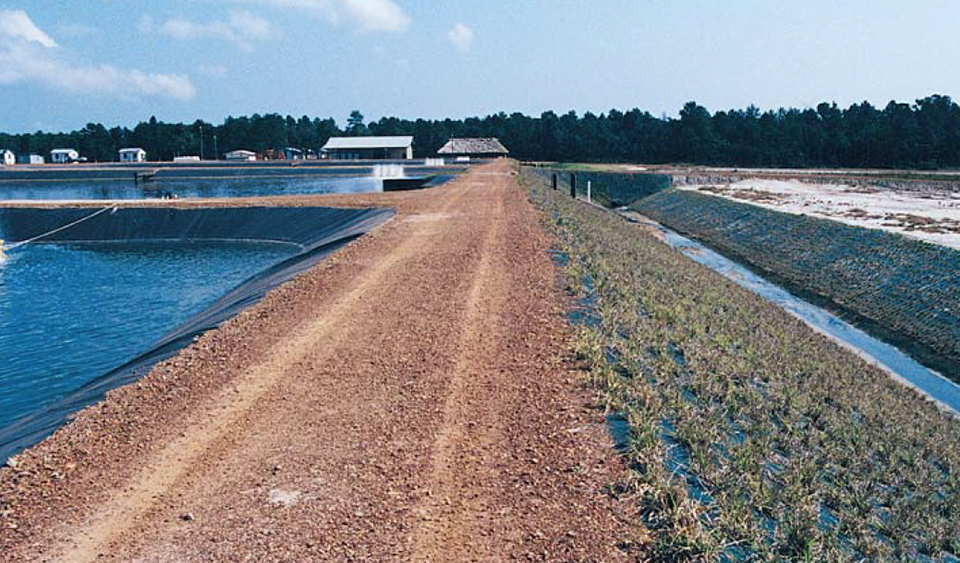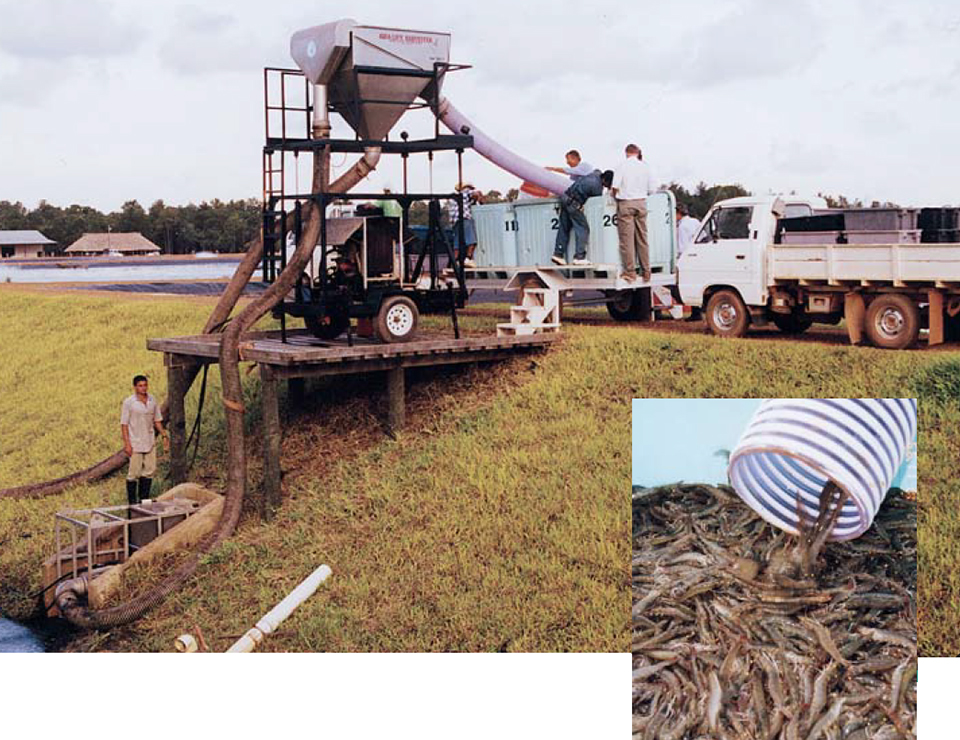Pond design and operation considerations

Pond yields have averaged greater than 13,500 kilograms per hectare for the past two years when culturing the Mexican strain of the Pacific white shrimp (Litopenaeus vannamei) in a zero water exchange system. Much of the success can be attributed to pond design and operational criteria that have been incorporated into the project.
Design and operational criteria
In order to accomplish the objective, a pond had to be designed in such a way that:
- a large biomass of shrimp could be maintained
- organic material could be kept in suspension, and detrital floc formation encouraged
- sludge from the pond bottom could be removed if large accumulations developed during the cycle
- pond bottom conditions would not deteriorate over time, even with the heavy loading associated with intensive aquaculture
- shrimp could be efficiently and rapidly harvested.
Pond design

Ponds at Belize Aquaculture are square, varying in size from 0.065 to 1.6 hectares. The depth of all pond bottoms slope from 1.4 meters at the water inlet to 2.3 meters at the point of harvest. In the 0.065 and 0.37-ha ponds, the point of harvest is at one end of the pond; in the 1.0 and 1.6-ha ponds, the point of harvest is in the pond center.
During the two years of trials, there has been no effect of pond size on yield per unit area; and as a result the commercial farm will be constructed using the center drain 1.6-ha square pond design. This four-acre pond has averaged 13,500 kilograms per hectare per harvest during the year that it has been operational.
Importance of depth
Ponds at Belize Aquaculture are deep; having a water volume of 18,500 cubic meters. This is 185 percent the volume of a typical semi-intensive shrimp pond having an average depth of 1.0 meter. Having this additional volume may explain partially why Belize Aquaculture is able to produce the amounts of shrimp that are produced when reported on a unit area basis. The extra volume of water is important for allowing the assimilation of the high organic inputs, creating a larger oxygen reservoir, and buffering temperature and other environmental variations that occur in the pond.
Maintaining solids in suspension
In a zero water exchange, intensive culture system it is important to keep solids in suspension as much as is possible. At times, the organic loading in our system can reach 500 kilograms of feeds per hectare day. Belize Aquaculture uses paddlewheel aerators to set up a circular flow pattern in square ponds. Around the outer areas of the pond where water flow rates are greatest, the detritus and other organics are kept in suspension. As the water flow rates diminish towards the center area of the ponds; largerheavier particles settle out. In our ponds water flow rates of 6.0 to 12.0 meters per minute are used keep organic material in suspension. Towards the middle of the pond the flow rates decrease to less than 6.0 meters per minute, and solids begin to fall out of suspension.
Aerator placement
The location of the aerators is important in optimizing the culture area where solids are kept in suspension. Paddlewheel aerators placed at a point 30 percent distant from each side sets up a water flow pattern that keeps detritus suspended in over 75 percent of the pond. In the middle area of the pond, where detritus tends to settle, we set up a strongly directional water flow aimed at the bottom of the pond using aspirator-type aerators. This results in the re-suspension of organic material; and the movement of the material back into the circular flow patterns created by the paddlewheel aerators.

Maintaining dissolved oxygen
In addition to providing the ponds with water movement, the paddlewheel aerators also provide the oxygen to the system. When shrimp biomass levels reach 13,500 kilograms per hectare, the pond oxygen consumption can be greater than 2.0 milligrams per hour. We have found with zero water exchange you can produce approximately 550 kg of shrimp per applied horsepower of paddlewheel aeration. The commercial four-acre pond has a total of 48 applied horsepower, and water oxygen levels never fall to less than 3.0-ppm oxygen.
Even with the heavy aeration, oxygen levels decrease as you move towards the center of the pond. Oxygen levels are generally saturated in the outer areas of the pond where water movement is greatest; but as you move towards the center where sludge deposition occurs; oxygen levels can be lower than 1.0 ppm. Proper placement of aerators can maximize the oxygenated zones, and minimize the areas of the ponds that are oxygen deficient.
Sludge removal
When pond yields exceed 10,000 kilograms per hectare, we have found that it is beneficial to remove sludge that accumulates in the center of the pond during the culture cycle. Sludge removal generally starts in the tenth week of culture. In smaller ponds less than 1 acre we use a centrifugal trash pump to remove sludge from the center into the drainage canals. The commercial ponds have been constructed with a sump of 20-meter radius that aids in the accumulation of the sludge. With this system we attach a hose off the center drain that can then be moved around the sump for removal of the sludge deposit. All sludge that is removed into drainage canals eventually is washed into settling basins where the sludge is accumulated.
Plastic pond liners
Another very important feature of pond design at Belize Aquaculture is the use of HDPE liners. We have used both 30 and 40 mil plastic liners; with the 40 mil liners being slightly more durable and more appropriate for the application. The use of plastic liners is essential when you are creating the directional water flow with the velocities needed to keep solids in suspension. Without liners there would be serious erosion of pond banks, and an unmanageable level of solids building up in the pond.
Another benefit to using the liner is the increase in pond-use efficiency. After a harvest, we can remove the small amount of accumulated sludge and restock the pond within a week of the harvest. During the year pond would have shrimp growing 95 percent of time, with the pond out of production for only 21 days per year. Ponds with natural soils typically have pond use efficiencies of around 75 percent, because these ponds need to be dried and the soils tilled and oxidized. We feel that this increased pond use efficiency pays for the initial costs of the liner and liner installation.
Other benefits to using a liner have been that we do not need to worry about soil composition when building ponds. Sandy Soils or soils with very acidic characteristics are of no concern. Also we have learned that lined ponds, with steep slopes dissuade wading birds from predating in the ponds. Birds have a difficult time negotiating the steep, slippery slopes of a lined pond.
Replacement of natural soils to plastics as the pond bottom substrate does change the some of the models for pond water chemistry. One example of this is the alteration of the phosphorus cycle in the pond. With natural soils, much of the phosphorus that is loaded into the pond is absorbed by the soils. With plastic soils, there is no adsorption of phosphorus, and as a result in zero exchange systems the pond water phosphorus levels increase linearly over the period of the cycle. Phosphorus levels in ponds at Belize Aquaculture often exceed 20 ppm at the end of a cycle. In addition to changes in water chemistry; pond liners also effect the coloration of the shrimp. Adark colored liner will result in shrimp with a darker coloration at harvest.
Erosion control
Erosion is controlled on the outside of pond dikes by the establishment of St. Augustine grass soon after construction is completed. The prevention of erosion is important on our ponds. Because the soils are sandy, heavy rains can cause tremendous amounts of dike material to wash out into local streams and off shore waters. This erosion causes unnecessary maintenance costs, as well as leading to a deterioration of the local waters. Topsoil that is removed from the pond area during construction is stockpiled, and placed on the dikes after construction of the dikes is completed. Sprigs of St. Augustine grass are then planted, and the planted area is fertilized. This results in rapid, vigorous coverage of the dikes by the grass, and a minimization of dike erosion.
Harvesting method

Harvesting is accomplished with a fish pump that moves the shrimp from the harvest basin up to a de-watering tower, and directly into insulated containers mounted on trailers for rapid movement to the processing plant. It is essential to be able to drain and harvest the ponds within a five hour period, as much of the shrimp will hang back until the final 20 percent of the water is coming out – and it is at this point in the harvest that the aerators are nonfunctional. At the very end water being pumped from the pond is returned to the pond instead of to the drainage canal to add needed oxygen to the final stages of the harvest. We have also found that shrimp can be crowded early using a seine net and forced to the harvest basin before critical oxygen levels are encountered at the end of a harvest.
Water pumping and filtration
Zero exchange culture systems do not require much water. Our water pumping and distribution system is designed to fill a pond in 24 hours. Thus for a 120 hectare farm, we will require a pumping/distribution network capable of 12,500 liters per minute. With such a relatively small flow we can concentrate on precise filtration of incoming water, and if necessary the more radical water treatments such as chlorination.
Currently we filter all incoming water through a 180-micron filter sock two times, the first time as it enters the seawater reservoir, and a second time as it is pumped into the culture pond. Originally we filtered water down to 250 microns, but we learned that filtering to this size allowed a considerable amount of biological contaminants to pass into the pond. A major biological contaminant that has been eliminated by using the 185-micron filter are the larvae of barnacles that can be a nuisance if they settle on the HDPE liners.
And finally the philosophy of Belize Aquaculture has always been to “do it right.” Implementation of project plans using correct designs and quality installation techniques reduces the amount of time that management needs to allocate to fixing facility “glitches” and emergency maintenance. Management is allowed instead to concentrate on the business of growing shrimp. Designs are reviewed and construction practices implemented that result in a facility requiring minimum maintenance to deliver reliable results over many years.
As an example, where most paddlewheels may use galvanized steel in the construction, Belize Aquaculture would invest in stainless steel. And in the area of power generation, instead of depending on multiple units of lower cost, high RPM generators, we are investing in a power station that will be backed up by the lower cost electric generators. Part of the philosophy also applies to the employee. First class housing is provided to all employees that live on site.
(Editor’s Note: This article was originally published in the February 2000 print edition of the Global Aquaculture Advocate.)
Now that you've finished reading the article ...
… we hope you’ll consider supporting our mission to document the evolution of the global aquaculture industry and share our vast network of contributors’ expansive knowledge every week.
By becoming a Global Seafood Alliance member, you’re ensuring that all of the pre-competitive work we do through member benefits, resources and events can continue. Individual membership costs just $50 a year. GSA individual and corporate members receive complimentary access to a series of GOAL virtual events beginning in April. Join now.
Not a GSA member? Join us.
Author
-

Robins P. McIntosh
Belize Aquaculture, Ltd.
#1 King Street
P.O. Box 37
Belize City, Belize, Central America[116,101,110,46,108,116,98,64,97,117,113,97,101,122,105,108,101,98]
Related Posts

Intelligence
Changing paradigms in shrimp farming, part 1
Conventional wisdom for farming white shrimp involves semi-intensive culture in large ponds, routine water exchange and reliance on wild broodstock.

Intelligence
Changing paradigms in shrimp farming, part 2
The focus at Belize Aquaculture Ltd. was to use clean animals that perform well at high densities and in waters with high nutrient loads.

Intelligence
Changing paradigms in shrimp farming, part 4
In high-density systems with zero water exchange, pond ecology shifts from an autotrophic, phytoplankton-based microbial community to a heterotrophic, bacterial-based community.

Intelligence
Changing paradigms in shrimp farming, part 5
A zero-water-exchange strategy to produce shrimp reduces the effluents and sediments that would normally be released to the environment by a typical intensive shrimp farm.

